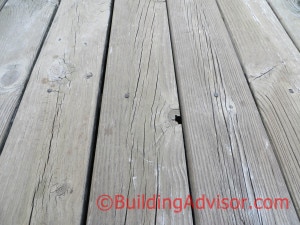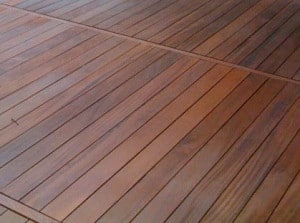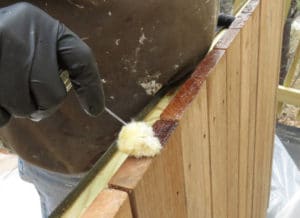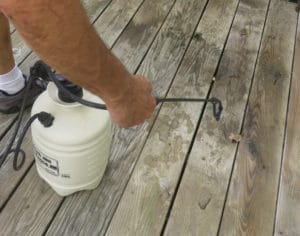See also Choosing Wood Decking View all DECKING Articles
In times past, I always went for an oil-based, semi-transparent deck stain. I applied it to a new pressure-treated deck after it had a little time to dry out and open the wood pores, but before any serious weathering took place which damages the wood fibers on the surface. I’d typically apply two coats the first year, and then one coat in subsequent years as needed. Before re-coating, I’d usually do a quick cleaning with a hose and stiff brush, using a commercial deck wash if there was visible mold or mildew. A simple hand-held garden sprayer with a wand makes this job quick and easy.

Nowadays, there is a bewildering variety of deck finishes including clear coatings and stains ranging from transparent and semi-transparent to semi-solid, and solid. In general, more pigment helps protect the wood from UV, but hides the natural grain and texture of the wood. Also too much pigment makes the stain act more like a film-forming paint, subject to peeling.
The oil-based formulas used for decades have been modified in recent years to reduce VOCs (volatile organic compounds) that cause air pollution. A number of acrylic stains have also been introduced to compete with oil-based finishes. These have improved over the years, but have not yet gained wide acceptance. With formulas changing all the time, the same product may be different than the one you bought one or two years ago. Formulas also may differ in different parts of the country depending on local air-quality regulations.
In my experience, traditional oil-based penetrating stains perform the best on decks, although they are not available in all states. “Modified” oils with reduced VOCs vary in their performance. Some clean up with water, which is a plus, but tend to create more of surface film, subject to peeling.
Clear finishes. There are a wide variety of clear finishes for decks. The most commonly used are wax-based “deck protectors” like Thompson’s Waterseal. These are more-or-less like car wax and need to be applied at least once a year. When newly applied, water will bead up like on a freshly waxed car. When the water no longer beads up, it’s time for a new coat.
If kept up, wax finishes will help the deck resist water penetration and slow down weathering. Some are enhanced with UV protectors and offering a little more protection. Some clear finishes have preservatives as well and are referred to as “water-repellent preservatives.”
I used to thumb my nose at these products, but now use a water-repellent on older decks to extend the life of the semi-transparent stain for a few more years between re-coating. I have also used them over hardwood finishes to extend their life. While I wouldn’t recommend a wax coating as your primary finish, it’s quick and easy to apply, and provides good protection for a year or so.
Another class of clear finishes are penetrating oils used mostly for hardwoods. These are described under “hardwood finishes” below.
Transparent and semi-transparent oil-based deck stains. These are still my go-to finish for softwood decks, whether pressure-treated or more expensive decay-resistant species such as cedar and redwood. I prefer a semi-transparent stain, also called translucent, which has enough pigment to protect the wood from UV, but still lets the natural wood grain show through.
Semi-solid and solid oil-based stains. Moving up in the amount of pigment are semi-solid stains. I have tried a semi-solid oil-based stain (Cabot) by accident, thinking it was my usual semi-transparent stain until I started spreading it. While I don’t like the appearance as much as much as a semi-transparent stain, it has held up well to the elements and has not peeled. So-called solid stains are a film-forming finish, which acts more like watered-down paint than stain. While solid stains can work well on rough-textured wood siding, I would avoid using solid stains or paints on horizontal surfaces, except in very dry climates.
Finishing Hardwood Decks

Tropical hardwood finishes. With the growing popularity of tropical hardwood decks, paint companies have introduced a number of finishes specially formulated for hardwoods. These tend to be high quality penetrating oils with UV blockers. In general, these finishes have enough pigment to enhance the natural color of the hardwood while still allowing the grain to show through. As with other deck finishes, pigmented stains provide better UV protection than clear or nearly clear ones.
Standard deck finishes may be too thick to absorb properly in dense hardwoods, leaving a sticky surface that will take a long time to dry. Also the finish may flake over time if it was not fully absorbed. Even with specialized hardwood finishes, you can end up with an unpleasant sticky surface if you don’t wipe away the excess finish on hardwood within 10 to 15 minutes of application.
Depending on the type of hardwood, apply one to three coats. On Ipe and other very dense woods such as Cumaru, apply only a single coat, being careful to wipe away any excess stain. With pigmented finishes, it’s best to apply the finish to only one or two boards at a time so as not to create uneven blotches.
Popular finishes for hardwood decks include Sikkens ProLuxe Deck Stains (now PPG), Messmer’s UV Plus for Hardwoods, Cabot Australian Timber Oil., Ipe Oil, and Penofin Penetrating Oil Finish for Hardwood. For most hardwoods, I prefer a “natural” light tint, while others prefer a heavily pigmented coating like Cabot’s “Mahogany Flame” color. Always test on a scrap piece or inconspicuous area before committing to the entire deck.
Some of these finishes are not available in all states due to air quality regulations, which limit the use of VOCs (volatile organic compounds) used in solvents. Some companies have introduced “modified” oil or fully water-based formulations. The labels can be hard to decipher, but if the product uses water for cleanup, then it’s not the original oil-based version.
In general, traditional penetrating oils will perform better in hardwood due to better penetration into the dense wood. How well the new versions perform is up for debate. Also manufacturers continue to tweak their low-VOC formulations so a review of last-year’s version might no longer be valid.
One of the first water-based products in wide use was Cabot Australian Timber Oil (Series 19400). This has generally received good reviews and I have used it successfully on a small mahogany deck. Still, it’s best to test the product on a small area (a few boards lengthwise) before committing to the entire deck.
Both the choice of finish and application are critical for success with hardwoods.
Read more about Hardwood Decking.
Applying Deck Finishes
Whether applying a deck stain to new wood or refinishing, you want a dry surface that will allow penetration of the finish. But don’t wait so long that the surface begins to weather and the wood fibers to deteriorate. Also remember to test the color on a scrap piece of lumber or where it won’t show. This is critical as the actual color of pigmented finishes may look nothing like the color chart. I’ve even used “clear” finishes that turned out to have a significant tint — and not always a pleasing one.

End-grain sealing. End grain sucks up water like a straw. This is often the first place to rot on softwood decks and a common place for cracking (end checking) on hardwood decks. To prevent problems, end grain should be sealed on all decking. On softwood decks, use a good copper-naphthenate-based wood preservative and sealer.
On hardwoods, seal ends as soon as the wood arrives, and as soon as final cuts are made, using a wax-based end-grain sealer (or multiple coats of the same finish used on the surface). End checking can make a mess of the beautiful hardwood decking that you have just spent a bundle on. Several end-grain sealers are formulated specifically for hardwood decking. Some include a handy applicator that simplifies the task of coating the end grain without staining the surface of the board. It doesn’t take long to seal the cut ends and you only get one chance — before the boards start to crack.
Weathering. On new material, it may be best to wait a couple of weeks, especially with fresh pressure-treated stock that is not kiln-dried. A good rain or hosing can help prepare the the surface, but then wait for 2-3 sunny days. You can test the surface by sprinkling a few drops of water or clear oil to see if it absorbs quickly. If you have access to a moisture meter, look for a moisture content of 12% or less.
If you have to wait much more than a couple of weeks before finishing, and the deck is exposed to full sunlight, then you should lightly sand the deck with 60 – 80 grit sandpaper to remove the damaged wood fibers before applying the first coat of finish.
Brush or spray. On softwoods, you can apply with a wide brush or low-pressure sprayer, but on hardwoods a wide brush is best. If you do use a sprayer, it’s a good idea to brush as well (back-brush) behind the sprayer to avoid puddles, work the stain in, and get good adhesion to the deck surface.
How many coats? Apply one to three coats depending on the type of finish and and wood. In general, new softwoods will take 2-3 coats while dense woods take one or two — one coat only for Ipe and other super dense hardwoods. On the other hand, a long-neglected pressure-treated deck exposed to full sun may soak up multiple coats. Whatever finish you use, make sure you wipe off any excess finish before it dries into a sticky mess. This is especially important with penetrating oils on hardwoods.
Hardwoods. If you’re using a pigmented stain on an expensive hardwood deck, be careful to coat only one or two boards at a time, working from one end to the other. You can use a paint shield, available at hardware stores, or a long narrow piece of quarter-inch plywood to keep the stain off the adjacent board. Otherwise, double-coated areas may end up with a blotchy appearance.

When to recoat. This will depend mostly on the finish used and the exposure — as well as the type of wood. South-facing decks in full sun will need more frequent recoating than a covered deck or one in a shady area. Too much shade and moisture, however, along with pine needles or other organic debris that are left to sit create a mold and mildew farm, requiring frequent cleaning and recoating.
Before recoating, first clean with a commercial deck cleaner using a low-pressure garden sprayer (see photo). Before hosing off the cleaner, brush trouble spots with a stiff brush, which you can buy at any hardware store. This is a quick and easy process that does wonders for old dirty and mildewed wood decks. Read more on refinishing.
- Pressure-treated softwood decks need to be finished regularly or they will deteriorate. If you’ve taken pretty good care of the deck, you should get 2-5 years from a good quality deck stain. If you want to keep the wood looking new and shiny, however, you may need to refinish every year. If they are not maintained, pressure-treated decks may not rot, but they will check (crack) and splinter, look terrible, and eventually need replacement. If a deck has been badly neglected for a number of years, and is badly checked, it is difficult to protect no matter what finish you use as water will collect in the cracks and do further damage — especially in a freezing climate. You may get a few more years by replacing the worst boards and sanding the deck with a floor sander before refinishing.
- Hardwood decks. On tropical hardwoods, you have a choice. If you want to keep the rich dark color, you will need to refinish every year with a pigmented oil-based stain formulated for hardwoods. If you don’t mind a gray, weathered appearance, you can finish once and then let the decking weather to gray. If you let it weather to gray, you can always restore the beautiful hardwood color at a later date by cleaning, sanding, and refinishing.
Read more on Deck Maintenance and Refinishing Choosing Wood Decking
Tammy says
Best Anti-Slip Deck Oil?
Is there a penetrating oil stain for mahogany with anti slip properties.? The deck is super slippery when wet.
buildingadvisor says
I am only aware of one penetrating oil with slip-resistant properties. It’s called Osmo Anti-Slip Deck Oil. The product is made in Germany, but available in the US and Canada from specialty suppliers and by mail order.
Unlike most deck oils, Osmo’s product is based on vegetable oils (sunflower and soy), rather than the more common linseed and Tung oils. It also contains additives for drying, water-repellency, and increased traction in their anti-slip finish. It can be used on unfinished wood or over other penetrating stains.
I have not used this product, and would be interested to hear back from you if you try it. Of course, test first on a small section of the deck.
There are also thick, solid-color finishes with significant grit such as Berh Deckover Textured. This is a very thick opaque coating – somewhat like mud with sand mixed in – so probably not what you want on a beautiful hardwood deck. But maybe something to consider for stairs or other areas where a non-slip surface is critical.
I have had good luck with non-slip tapes and thick tread strips, made of the same material as exterior mats (photo below). In snow country, thick tread covers held in place with stainless-steel screws has worked well on slippery porch steps.
Noel says
There seem to be many paints, stains,and other finishes for wood decks. Do you have any advice on the most suitable finish for wood decks?
buildingadvisor says
This is a tough question as there is no single best product for all situations. What type of wood are you using? Tropical hardwoods take very different finishes than pressure-treated decking and other softwoods such as redwood and cedar, because standard finishes cannot penetrate the dense hardwoods and can leave a sticky mess. Do you want the grain of the wood to show through, or do you want a more solid color? Or are you hoping to preserve the natural color of the wood – a difficult goal to achieve with any wood?
I can say that I prefer oil-based finishes over water-based for decks. Also, that I would avoid all paints and solid stains, as they are film-forming finishes, which are prone to fail on deck surfaces and will require the unpleasant task of scraping before refinishing.
That leaves you with oil-based penetrating stains, which come in transparent, semi-transparent, semi-solid (and solid), variations. The main difference is the amount of pigment in the formulation. In general, more pigment provides better UV protection for the wood and, in theory at least, should last longer – as long as it does not a create a peeling film.
I have always gone with semi-transparent, oil-based deck stains, but have also used semi-solid which has also held up well, but with a different look. As for one brand vs. another, it’s hard to say as the companies are always changing their formulations. For many years I went with Cabot deck stains, but I’m not sure I can recommend them today. You might get some good advice from a contractor-oriented lumberyard. You might also find some head-to-head testing at Consumer Reports and similar publications.